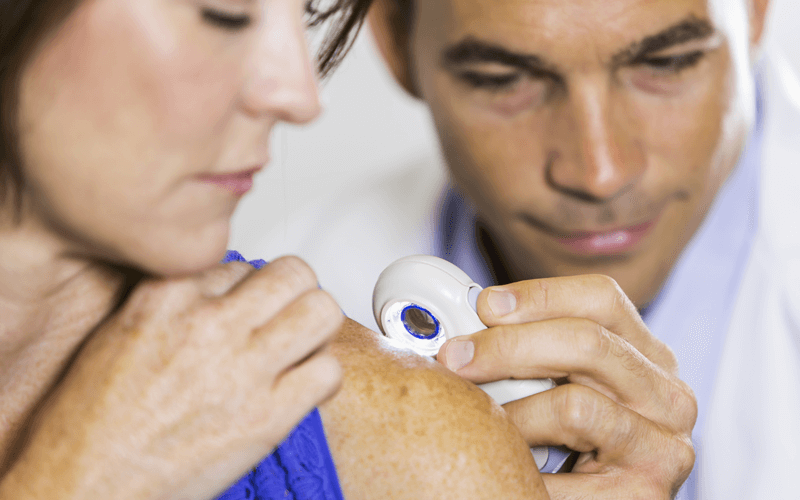Each year, over 5.4 million cases of non-melanoma skin cancer are treated in the United States. Mohs surgery is a procedure that offers the highest cure rate for these skin cancers.
A diagnosis of skin cancer can be scary, but understanding your diagnosis and the available treatment options can bring you peace of mind. In most cases, when caught early, skin cancer can be effectively treated and cured.
Basal cell carcinoma is the most common form of skin cancer, with more than 4 million cases diagnosed each year from coast to coast. Squamous cell carcinoma, another common form of skin cancer that develops in the outer layer of the skin, is the second most common, with more than 1 million cases diagnosed annually in the U.S.
According to the Skin Cancer Foundation, between 40 and 50% of Americans who live to age 65 will either have basal cell carcinoma or squamous cell carcinoma at some point.
Melanoma, the deadliest form of skin cancer, only accounts for about 4% of all skin cancers, but it is the leading cause of cancer death among 25- to 30-year-old women.
Though basal cell carcinoma and squamous cell carcinoma are not typically life-threatening, they can both be aggressive. In some cases, they can spread to nearby bones and tissue if left untreated. These types of skin cancers are typically considered to be “low risk” because the affected cells are clustered together in a single group. The fact that they are contained in one area means the tumors are easier to treat. In most cases, cancer can be completely removed with surgery.
What Is Mohs Surgery?
Mohs surgery offers cure rates as high as 99% for cases of squamous cell carcinoma and basal cell carcinoma — cancers with a high risk of recurrence. Named after Dr. Frederic Mohs, who performed the first procedure in the 1930s, Mohs micrographic surgery is a highly specialized surgical technique used to treat non-melanoma skin cancers.
Not all tumors are perfect spheres; many have tentacles below the surface of the skin. Mohs surgery allows the surgeon to remove all of the visible cancer, layer by layer, as well as a small amount of the surrounding healthy tissue. Each layer is then examined under a microscope to ensure all of the cancer cells have been removed.
“The primary benefit of this surgery is its microscopic accuracy,” Dr. John M. Biltz of U.S. Dermatology Partners of Waxahachie. “It completely removes the skin cancer, layer by layer, with minimal impact to the surrounding healthy skin.” Unlike other cancer treatments, which force surgeons to blindly estimate the amount of tissue to treat, Mohs surgery enables the surgeon to evaluate 100% of the surgical margins. This minimizes the amount of surrounding healthy tissue affected and ensures that the cancer has been removed entirely.
Ultimately, the procedure is the most effective and most aesthetic solution to curing skin cancer. It is also cost-effective because most patients only require a single surgery to completely remove the tumor.
Is Mohs Surgery Right for You?
Mohs surgery is recognized by most doctors as the preferred method for treating non-melanoma skin cancers. It is an especially effective treatment for lesions on the face because the cosmetic damage to surrounding skin is minimal.
Whether or not Mohs surgery is right for you depends on your history of skin cancer, the type of skin cancer and the location of the tumor. Though most often used for low-risk cancers, Mohs is also used to treat high-risk or recurring skin cancers because of its ability to completely remove the tumor with a high degree of accuracy.
Often, if you have basal cell or squamous cell carcinoma and are at risk for recurrence, you are a good candidate. It is also a good choice for patients with tumors larger than two centimeters, tumors that have regrown after previous treatment or tumors in locations like the face, where it is critical to preserve the surrounding tissue.
This procedure is also ideal for removing tumors with poorly defined borders, as well as tumors in patients with suppressed immune systems.
Mohs surgery is an outpatient procedure that is performed under local anesthesia. No hospitalization is required. Your surgeon will remove each layer of cancer-containing skin, one at a time, examining each layer under the microscope as you wait in the waiting room with a pressure dressing on the wound. The process is then repeated until no more cancer cells remain.
Side effects are minimal and include some bleeding from the wound, tenderness and minor pain around the surgical site. Following surgery, you should continue with regular visits to your dermatologist to ensure the cancer does not return.
Looking to See a Mohs Surgeon?
If you think you may have non-melanoma skin cancer, you should contact a dermatologist immediately for a full skin examination. To learn more about Mohs surgery and other innovative treatments for skin cancer, fill out our simple online form to get in touch with us. One of our local team members will reach out to you shortly to answer your questions or schedule an appointment for you to visit us soon.
Find a location near me
or

